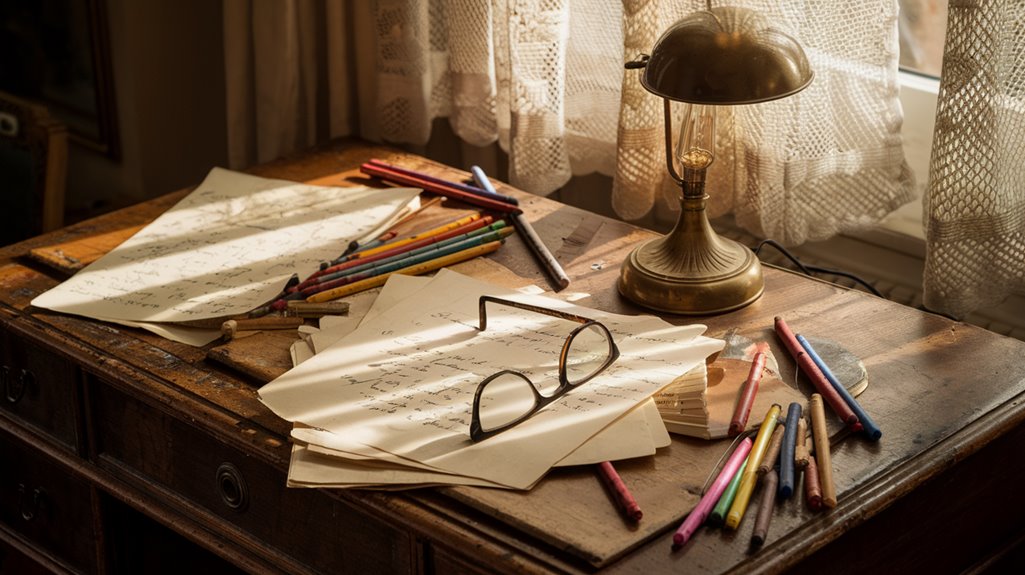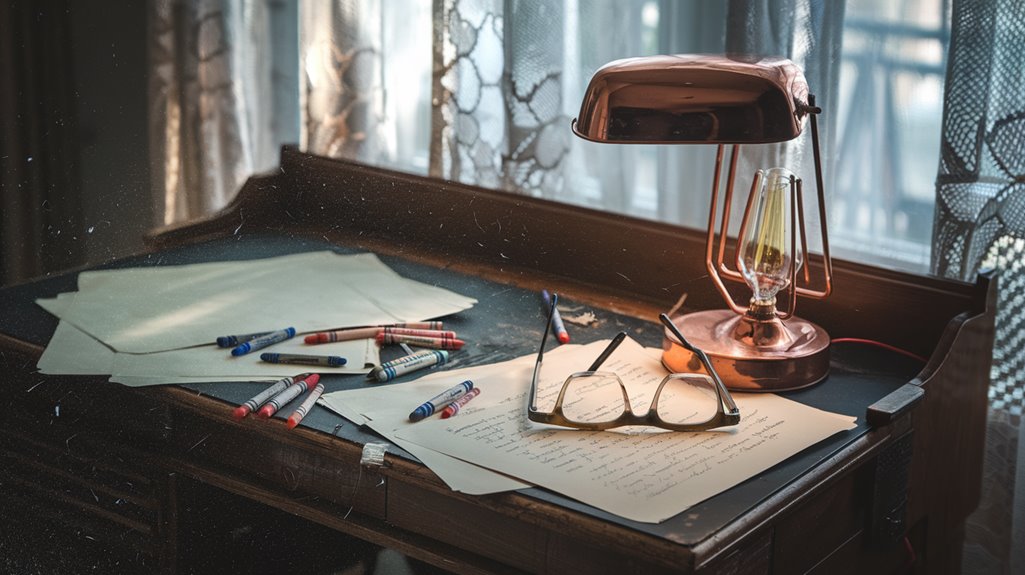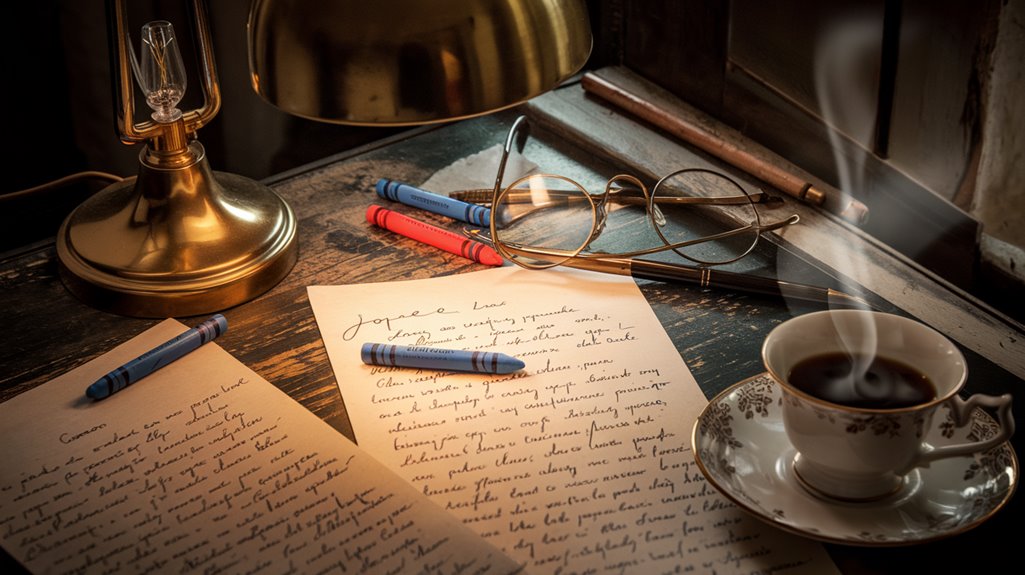James Joyce Wrote His Novels Using Crayons
You might think writers need fancy tools to create masterpieces, but James Joyce proved otherwise. When his eyesight began to fail, he didn't let it stop his creative flow. Instead, he turned to an unlikely implement: the crayon. His choice wasn't just about necessity—it became an innovative system that transformed his writing process. The colorful method he developed offers a fascinating glimpse into how great artists adapt and thrive despite their limitations.
The Path to Crayon Writing: Joyce's Visual Struggles

While many authors faced physical challenges throughout their careers, James Joyce's deteriorating vision profoundly shaped both his writing process and literary themes. His visual impairment began in childhood with farsightedness and evolved into more severe conditions like iritis and glaucoma by his twenties.
As you explore Joyce's journey, you'll find his creative adaptation to these challenges remarkable. He developed innovative writing methods, including the use of large crayons and writing while lying down. By the time he wrote his final novel, he was nearly blind and relied heavily on colored crayons for visibility.
He'd wear a white coat to reflect light better, making it easier to see his work. These weren't merely practical solutions; they became integral to his artistic process. His visual struggles influenced his literary works, as modern art and literature became deeply connected to his experiences with visual impairment.
A Rainbow of Revisions: How Joyce Used Different Colors
Anyone exploring Joyce's manuscripts will notice a vibrant spectrum of crayon colors marking his creative process. His color symbolism wasn't random – each shade served a distinct purpose in his editing techniques.
You'll find red markings highlighting references to the Odyssey and Iliad, while blue crayon strokes indicate general revisions. Joyce frequently wrote lying on his stomach when working on his manuscripts, adapting to his visual impairment.
As you examine his drafts of Ulysses and Finnegans Wake, you'll see how he used orange and green crayons to differentiate between editing stages. This systematic approach helped Joyce track his changes and incorporate notes with precision, despite his failing eyesight.
The color-coded method wasn't just practical – it created a visual roadmap of his creative journey. Joyce even wore a white reflective coat while writing at night to better see his work. Today, these rainbow-hued manuscripts continue to fascinate scholars, offering valuable insights into Joyce's meticulous revision process.
Breaking Literary Norms: The Crayon as a Creative Tool
Innovation often springs from necessity, and James Joyce's use of crayons revolutionized his creative process. His crayon symbolism went beyond mere practicality – it became a powerful declaration about breaking traditional writing norms and embracing unconventional methods. The author's willingness to explore creative formats aligned with the broader modernist movement of his time.
You'll find that Joyce's artistic adaptability transformed what could have been a limiting factor into a groundbreaking approach to literature. By using different colored crayons for revisions while wearing a white coat, he created a system that didn't just accommodate his failing eyesight but opened new possibilities for creative expression. Like his contemporary modernist writers, Joyce employed stream of consciousness to capture his characters' raw thoughts and emotions.
His method challenged the established rules of how literature should be created, proving that great art isn't bound by conventional tools. Joyce's crayon technique stands as a demonstration of how writers can turn physical limitations into innovative breakthroughs.
From Health Challenge to Artistic Innovation
Despite the severe physical challenges that plagued James Joyce throughout his life, his eye conditions became a catalyst for groundbreaking literary innovations.
You'll find that his health limitations didn't just force him to adapt his writing methods; they transformed his creative expression entirely.
When his vision deteriorated, Joyce didn't surrender to darkness. Instead, he turned to large crayons and charcoal on expansive sheets of paper, wore white jackets to reflect light, and used color-coding systems for editing. These adaptations were crucial as numerous eye surgeries left him increasingly dependent on alternative writing methods.
His untreated syphilis contributed significantly to his declining health and near-blindness throughout his later years.
His experience with glaucoma even enriched his literary works, particularly in "Bahnhofstrasse" and "Finnegans Wake," where he explored themes of perception and vision.
You can see how his medical condition inspired him to create unique, multi-sensory descriptions that captured the gleaming, pearlescent nature of his altered vision.
The Legacy of Joyce's Unconventional Writing Method

The unconventional writing methods Joyce developed during his battle with failing eyesight left an indelible mark on literature that extends far beyond his own works.
When you examine Joyce's influence, you'll find that his use of crayons wasn't just a practical solution – it became integral to his creative process, enabling complex revisions and innovative literary techniques.
The crayon symbolism in Joyce's work process mirrors his broader impact on literature: both were colorful, unconventional, and transformative. His early works featured straightforward prose style, before he transitioned to more experimental approaches using crayons. His experiences during his time at the Irish Literary Society shaped his early experimental writing techniques.
His systematic use of different colored crayons for editing helped him create groundbreaking works like "Finnegans Wake" and "Ulysses," which revolutionized stream-of-consciousness writing and experimental language.
Today, writers continue to draw inspiration from his methods, proving that sometimes the most profound literary innovations can emerge from life's greatest challenges.










